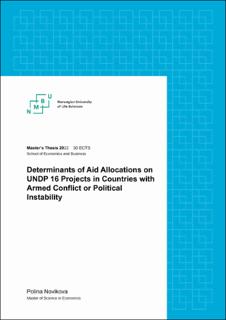| dc.description.abstract | The United Nations (UN) is a multilateral organization that addresses issues that transcend national boundaries. The UN Membership approved in 2015 “The 2030 Agenda for Sustainable Development”, which is built on 17 Sustainable Development Goals (SDGs) that serve as the guidelines to all countries - developed and developing - in a global partnership towards achieving a better world (UN, 2022).
The UN Development Program (UNDP) is one of the 15 UN agencies that focus on international development to achieve the SDGs. The thesis studies factors determining UNDP SDG 16 (Peace, Justice and Strong Institutions) aid allocations for projects in countries with armed conflict or political instability (UNDP, 2019b). The topic’s relevance lies in the UNDP`s mission statement: “to eradicate poverty and reduce inequality. We help countries to develop policies, leadership skills, partnering abilities, institutional capabilities, and to build resilience to achieve the Sustainable Development Goals.” Thus, the multilateral organization’s transparency and criteria affecting the decision-making process behind the allocation of project funds is an important topic to research.
The objective is to determine the factors that affect aid allocations under SDG 16 related to projects in countries with armed conflict or political instability during 2016-20.
The research targets aid allocations for projects for peaceful resolution in countries with armed conflict or political instability as a dependent variable relying on the indicators of the recipient country`s requirements based on GDP per capita, number of victims during the years of conflict, and democracy indexes, etc. A panel data set of 150 observations covering 2016-2020 on 30 recipient countries and ten donor countries was collected to build an econometric model (fixed-effects and random-effects models), together with partial qualitative analysis on the data-generating stage to define the factors affecting the UNDP project aid allocations to recipient countries under SDG 16.
The key findings of the thesis suggest, as expected, that there is insufficient understanding of the decision-making process in the UNDP allocation system. According to findings, the poorer countries with the larger territory and smaller populations tend to be chosen to receive aid for SDG 16 projects from the UNDP. The results suggest that conflict-specific variables, such as civilian casualties and the size of the country affected by conflict or political instability are considered during the aid allocation decision-making process, which was to be expected based on the specifics of the projects analyzed. Moreover, there is evidence, through both qualitative and quantitative methods to suggest that US interest levels in the country in conflict (e.g., Afghanistan) have a major influence on aid allocation within UNDP SDG 16 projects. Nevertheless, there is no evidence in the data that suggest there is an influence of the amount of monetary contribution by the top 10 donor countries on the aid allocation process for SDG 16 projects. | en_US |

